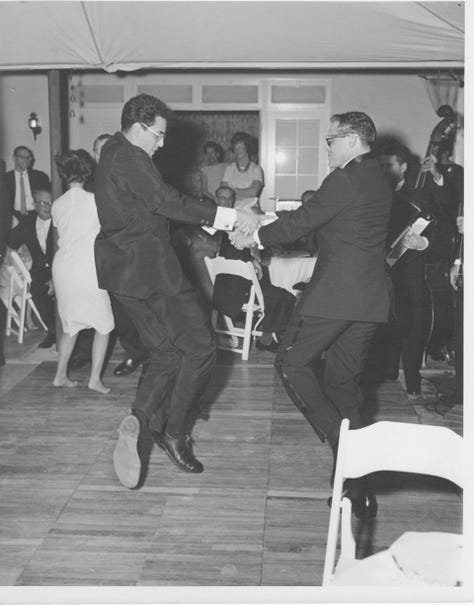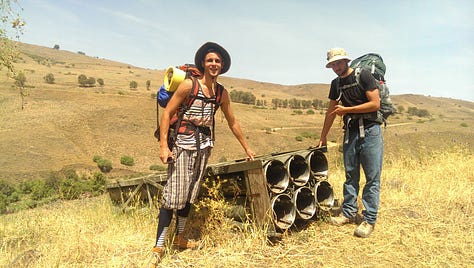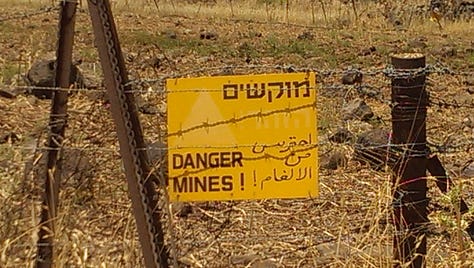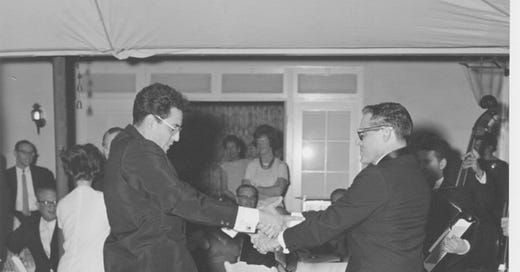Photo: Victor and my father dancing at the wedding of my parents.
Back yard of my grandparents’ home at 701 North Rexford, Beverly Hills. 1964
>>>
In this parsha:
Jacob follows the parental advice to leave home to escape the wrath of Esau. On the way he lies down for the night and sees the ladder reaching to heaven. Gd appears to Jacob and promises the land to him.
Jacob marks the place with a stone monument and proceeds to Haran where he finds a well covered with a stone and flocks of sheep waiting to be watered. Rachel arrives with the flocks of her family. Jacob waters Rachel's sheep [much as Rebecca watered Eliezer's camels a generation earlier]. Jacob says to Laban (father of Rachel) that he will work seven years as a bride price to marry Rachel.
Laban accepts the offer. Jacob spends seven years working for Laban and is then deceived into marrying Rachel's older sister Leah. Jacob discovers the deception the next morning and makes a deal to work another seven years for Rachel's hand. [A direct read of the text indicates that Jacob received Rachel first and then worked the seven years, where he initially put in the years prior to marrying Leah.] Leah conceives sons. Rachel is barren and pulls her maidservant Bilhah into the breach (as it were). Bilhah conceives. The heads of the 12 Tribes of Israel are born to Leah, Rachel and their maidservants. The last (in this parsha) is when Rachel finally conceives and gives birth to Joseph. (Benjamin is born in next week's parsha.)
Jacob and Laban split up the herds and go their separate ways. Jacob's expertise in animal husbandry leads to great wealth. (Perhaps his many sons added to his effectiveness?) Laban becomes jealous of Jacob's wealth. Jacob recounts the provenance of his wealth to remind us for all time that what he has is strictly according to the terms agreed with Laban. Jacob and family (and herds) ride off to Canaan.
Rachel now steals her father Laban's idols. When their absence is noted, Laban gives chase. Jacob says the member of his household who stole the idols will be put to death. Rachel sits on them to prevent them from being found when Laban ransacks the tents. (A lie to save a life at this point.) [Officer-created Jeopardy?]
Jacob is upset that Laban doubts him. Why? Because Jacob spent 20 years making profits for Laban. The dispute is settled and a monument is built as a memorial to the peace agreement. (Which includes a provision that Jacob not take additional wives. E.g. the family wealth is to remain with the descendents of Laban.)
Laban and Jacob go their separate ways. Jacob finds angels of Gd along the path and Jacob calls the place Mahanaim.
<<<
Thus begins the saga of the 12 sons of Jacob. The friction among the brothers seems like an inheritance. Laban deceives Jacob by putting the wrong daughter under the wedding veil. Years later, Rachel steals Laban's idols (payback?). Before any of the sons are born the two sister-wives are jealous of each other, having one upped the other (Rachel was chosen by Jacob, but Leah gets the scoop of becoming the senior spouse). This morphs into raw competition between sisters Leah and Rachel over providing sons for the family. Maternal jealousy then flows (in subsequent parshiot) to the spaces between the 12 brothers.
Interpersonal / relational and generational epigenetics.
These hard feelings will ultimately, in future parshiot, drive the brothers to the brink of fratricide.
But this parsha and its predecessors are also filled with agreements of peace. In earlier parshiot kings make peace with Avraham. In this parsha Laban and Jacob come to terms.
Peacemakers will also be found among the brothers. This comes later. But seeds of peace are there alongside jealousy, guilt and envy. Each parsha, it seems, has both deception and reconciliation. (Not always over the same matter or by the same people.)
This inter-parsha thread offers a meta lesson: In every era and situation, people of peace work from bare beginnings to keep us from falling completely off the rails.
The parsha ends in a place called Mahanaim. We understand this to be located just to the east of the Jordan river, between the Sea of Galilee and the Dead Sea. (E.g. to the south of Tiberias.)
There is another Mahanaim, 30 miles or so north of Tiberias. It is on route 90, the road to Metula, the northernmost tip of Israel. When I read Mahanaim in the parsha, I thought "I have hitch hiked from there several times."
Ahh, the cars and pickups I flagged were not at the Mahanaim of the Parsha. But for over 50 years, waving a car down there led to a man of peace.
One of the photos on my screen saver is my father and his best friend, Victor Friedman, dancing a Greek dance at the wedding of my parents in 1964. My mother always told me they danced for hours that night. Israeli and Greek dances. (In the back yard of my grandmother's house that was just sold in 2020.)
Victor lived until his death on Kibbutz Gadot. Until Israel Rail was built out in the North, the way you got to Gadot was to take a bus to Tiberias, and then get on the bus to Metula. Getting on that bus, ask for Mahanaim. At Mahanaim you hitch hike the last 5 or 10 miles to Gadot.
I last did this with my sons about five years ago. (Now there is a bus that goes from the nearest rail station to the Gadot entrance.)
Wait. The parsha is about overcoming competition and jealousy, not bus routes.
The parshiot show, over and over, how deception, jealousy and conflict lead to defensiveness and sometimes trauma. Undoing such damage takes work. (Is the exercise of building a stone monument part of processing a damaging experience? Note that the monuments are built from scratch.)
Victor, though he lived near Mahanaim-North for decades, did not build stone monuments. Rather, he went to a nearby Bedouin village several times a week.
To coach girls basketball.
For girls, activities in Bedouin and Arab towns are limited. Victor knew that basketball is a big personal development tool for Israeli youth. So he brought it first to a girls team at the Tuba-Zangariyye high school. And then the middle school. And then to girls so small they just drop the basketball into a bucket on the ground.
In this town of 6,000 a few miles from Gadot, Victor built a humane monument.
And in my household, over a few decades, the phone would ring every few years on a weekday night. A voice would say "It's Victor, I'm here." No advance notice. No awareness on our part that he was coming to the states. He was just here. And I'd go pick him up at whatever train or bus station he was at and he'd come over for dinner. And then I'd take him back to a train or bus station and send him on his way.
Victor was my father's closest friend. I often refer to him as an uncle. He played a far larger role in my life than any of my actual uncles. He was a kibbutznik who always had a kippah in his pocket when he travelled around the States.
He died in 2018. Our daughter Alma and I were at his funeral.
We turned right at "Mahanaim North" to get there.
A mukhtar from Tuba-Zangaria spoke. And reminded everyone that hurt, offense and trauma don't go away by themselves. And that Victor built a huge bridge between the villages and brought, year after year, a great gift to the girls of Tuba-Zangaria.
Making peace takes work.
---
יהודה עמיחי
עין יהב
נסיעה לילית לעין יהב בערבה
נסיעה בגשם. כן בגשם.
שם פגשתי אנשים שמגדלים תמרים.
שם ראיתי עצי אשל ועצי אשליה.
שם ראיתי תקוה דוכרנית כמו תיל דוקרני
ואמרתי בלבי: אמת, התקוה צריכה להיות
כמו תיל כדי להגן עלינו מן היאוש.
התקוה צריכה להיות שדה מוקשים
Ein Yahav
Yehuda Amichai
(Translated by Chana Bloch and Chana Kronfeld)
A night drive to Ein Yahav in the Arava Desert,
a drive in the rain. Yes, in the rain.
There I met people who grow date palms,
there I saw tamarisk trees and risk trees,
there I saw hope barbed as barbed wire.
And I said to myself: That's true, hope needs to be
like barbed wire to keep out despair,
hope must be a mine field.
----
Ein Yahav is a moshav in Israel, right on the Jordanian border. Located 100 m below sea level in the northern Arava, 12 km south of Hatzeva and between the Yahav and Nikrot streams, it falls under the jurisdiction of the Central Arava Regional Council. In 2019 it has a population of 742. (Wikipedia & Raf)
----



Photos:
Victor and my father Serge dancing at the wedding of Bunni and Serge (my parents). 1964
Noah and Manuel Zimberoff, on a hike near Gadot, by a minefield (שדה מוקשים)
~2016
Credits:
Rivy Kletenik who suggested in 2018 that Victor be the subject of a dvar torah.
--end--



